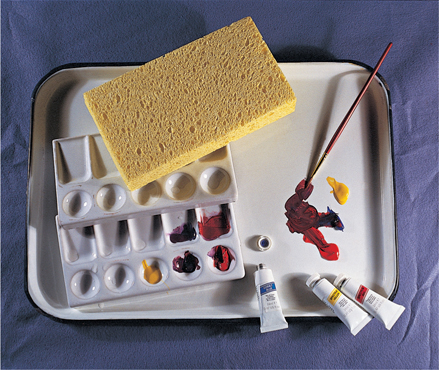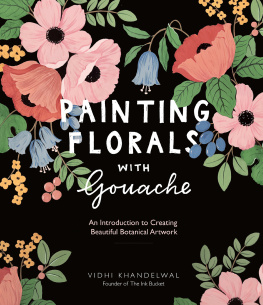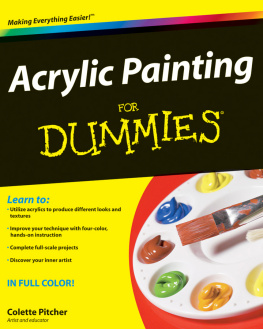Realistic Painting

There is a deep fascination with artwork that looks true to life. The aspiring painter often wonders how other artists are able to create works that are so persuasive. This book will show you step by step how these lifelike effects are achieved. Although other mediums can be used to achieve similar effects, I prefer gouache, or opaque watercolor. Gouache allows you to apply light colors over a darker underpaintinga method not possible with some mediums such as transparent watercolors. I also will show you how to work from photographs and use an airbrush to create amazingly detailed paintings. With practice, you will be able to build on your newly acquired skills and develop your own techniques for creating images with striking realism. Daniel K. Tennant

2010 Walter Foster Publishing, Inc. All rights reserved. Artwork on pages 115, 1727 1996, 2010 Daniel K. Tennant. Artwork on pages 16, 2831 2010 Daniel K. Tennant.
This book has been published to aid the aspiring artist. Reproduction of the work for study or finished art is permissible. Any art drawn or photomechanically reproduced from this publication for commercial purposes is forbidden without written consent from the publisher, Walter Foster Publishing, Inc.
Digital edition: 978-1-61059-871-2
Softcover edition: 978-1-60058-124-3
CONTENTS
MATERIALS AND TOOLS
For optimum results , always buy the best materials and tools you can afford. Inferior materials will make the project more difficult, which can be discouraging, and higher-quality materials will last longer.

GATHERING SUPPLIES Before painting, make sure you have all your basic supplies. Keep a bucket of water and a roll of paper towels on hand to rinse and dry your brushes between colors.
GOUACHE
Gouache is opaque watercolor (for more information, see ). For the best results, use high-quality, professional-grade paints, and select only those colors that are considered permanent. (Some pigments are fugitive, meaning that they fade when exposed to sunlight.) I recommend tubes over cakes because they are brighter, easier to mix large quantities of color, and have the best selection of colors.
BUCKET OF WATER
To ensure bright colors, use a bucket of water to rinse your brushes between colors. I recommend a gallon-sized bucket or can.
PENCILS
An HB pencil is good for preliminary drawings. HB lead is soft enough to leave a solid drawing, and gouache is not repelled when applied over it.
ERASERS
Standard rubber or kneaded erasers are good for cleaning up your drawings. The side of a kneaded eraser can be used for erasing large areas, and the eraser can be shaped to a point for erasing small areas.
CHECKING YOUR COLOR PALETTE
For the lessons in this book, you will need the colors listed below.
 alizarin crimson
alizarin crimson
 burnt sienna
burnt sienna
 burnt umber
burnt umber
 cadmium red
cadmium red
 cadmium yellow
cadmium yellow
 cerulean blue
cerulean blue
 Chinese orange
Chinese orange
 cobalt blue
cobalt blue
 Indian yellow watercolor
Indian yellow watercolor
 ivory black
ivory black
 ivory black watercolor
ivory black watercolor
 Naples yellow
Naples yellow
 permanent white
permanent white
 sap green
sap green
 sap green watercolor
sap green watercolor
 ultramarine blue
ultramarine blue
 violet
violet
 viridian green
viridian green
 yellow ochre
yellow ochre
 zinc white (Use zinc white for mixing. Permanent white may cause other colors to fade.)
zinc white (Use zinc white for mixing. Permanent white may cause other colors to fade.)
ILLUSTRATION BOARD
A hot-pressed (smooth) surface is recommended over a textured surface. It allows you to create your own textures, and it also provides for the greatest amount of detail. The heavier the ply of the board, the better. (Four-ply is recommended.) Another option is museum board, which comes in an eight-ply weight. (Also see .)
BRUSHES
I recommend only using red sable/synthetic hair watercolor brushes and a large flat watercolor brush for large areas. One of each standard size00, 0, 1, 2, 4, and 6should be sufficient. (I most often use a #2 brush.) A long-haired rigger brush is good for making thin lines. The large flat watercolor brush is excellent for laying in backgrounds quickly and smoothly and for covering large areas.

BUYING BRUSHES Good brushes are expensive, but if you wash them thoroughly after each painting session, they should last a long while. Rinse the brushes in cool or lukewarm (never hot) water, and lather them lightly with mild soap. Rinse them again, and then shape the hairs so that they dry with a sharp point.

SELECTING A PALETTE Whichever palette you choose should have enough wells to hold all your paint colors and a spacious flat area for mixing. Always place your colors in the same order on your palette to avoid wasting time searching for your desired color while painting.
PALETTES
There are many types of palettes available. My favorite is a china slant tile, which is made from baked ceramic and has 10 paint wells. It is portable, easy to clean, and has plenty of room for color mixing. A damp sponge laid over the entire tile will keep the paint wet for at least 24 hours. On extremely hot days, the sponge should be saturated with water. Other palette options include an enamel butchers tray or a piece of plate glass or Plexiglas with toned paper placed underneath to help gauge colors.







 alizarin crimson
alizarin crimson
